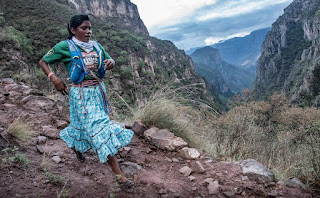July of 2017
Puebla, Mexico
Athletes from around the world have gathered for the
Ultra Trail Cerro Rojo, a 31-mile ultra-running competition.
In the women’s division there is a 22-year-old from Chihuahua
named Maria Lorena Ramirez. She is of the Tarahumara tribe. [More on that in a
minute.]
Lorena won the women’s division.
Why is this of note to readers of a blog titled “Indigenous
Ability?”
First, a few more details.
·
Lorena was a 22-year-old goatherd with no
special running training at the time of her victory.
·
She arrived wearing sandals and skirt.
·
Race organizer, Orlando Jiménez remarked, “She
carried no special accessories. She didn’t bring any gel, or energy sweets,
walking stick, glasses, or those very expensive running shoes that everyone wears
to run in the mountains.”
Readers of Christopher McDougall’s Born to Run
will likely point to her being of the Tarahumara tribe as “explanation” for how
she ran so well.
In fact, this explains nothing. McDougall’s
book [and its follow-up] are rife with special pleading, post hoc ergo
propter hoc, cause-confusion and a handful of other thinking and sampling errors.
[See Daniel Lieberman’s Exercised for an
elegant knockdown of these “easy” explanations.]
The answers as to how are likely complex—they are
definitely not the result of genetic endowment or by simple dint of being Tarahumara.
Such arguments do disservice to those who do the work, akin to “Asians are
good at math.” Sloppy thinking slides into racist compartments.
We will leave the complex factors that may be involved
for another time.
For now, it is sufficient to say what we do
know for a fact. Much of the gear, the apps, the training methods, the
garb we assume are necessary for athletic performance may be nothing more than “scientifically
verified” marketing scams that we adopt in lieu of what are the real essentials.
The Old Timers make a good argument that much of what
we consider necessary to do great things are mere impedimenta.
For more thoughts in this vein on the subject of athleticdiets see here.
For conditioning thoughts in this tack—see here.
[Excerpted from our book ROUGH & READY: Old World Strength &
Conditioning for Modern Warriors. See here for more Old School Tactics and Evil
historically accurate and viciously verified http://www.extremeselfprotection.com
.]

Comments
Post a Comment